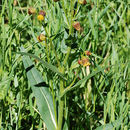Comments
provided by eFloras
The two varieties of Senecio bigelovii are distinguished by morphologic tendencies and by geography.
- license
- cc-by-nc-sa-3.0
- copyright
- Missouri Botanical Garden, 4344 Shaw Boulevard, St. Louis, MO, 63110 USA
Description
provided by eFloras
Perennials, (20–)40–80(–120) cm (caudices fibrous-rooted). Herbage usually floccose-tomentose to glabrescent, sometimes glabrous. Stems single or loosely clustered. Leaves progressively reduced distally; petiolate (proximal); blades ovate to lanceolate, 7–15 × (1–)2–5 cm, bases contracted or tapered, margins subentire or serrate to dentate (mid and distal leaves similar, sessile, bractlike, often clasping). Heads nodding (especially when young), (1–)3–12(–20) in racemiform or paniculiform arrays (terminal heads often largest). Calyculi of 4–10 linear bractlets (lengths mostly 1 / 3 – 1 / 2 phyllaries, sometimes 1 or 2 equaling phyllaries). Phyllaries ± 13 or ± 21, 6–12 mm, tips green. Ray florets 0. Cypselae glabrous. 2n = 40.
- license
- cc-by-nc-sa-3.0
- copyright
- Missouri Botanical Garden, 4344 Shaw Boulevard, St. Louis, MO, 63110 USA
Synonym
provided by eFloras
Ligularia bigelovii (A. Gray) W. A. Weber
- license
- cc-by-nc-sa-3.0
- copyright
- Missouri Botanical Garden, 4344 Shaw Boulevard, St. Louis, MO, 63110 USA
Senecio bigelovii: Brief Summary
provided by wikipedia EN
Senecio bigelovii or nodding groundsel or nodding ragwort is a perennial herb native to the Colorado Plateau region of the United States.
- license
- cc-by-sa-3.0
- copyright
- Wikipedia authors and editors

